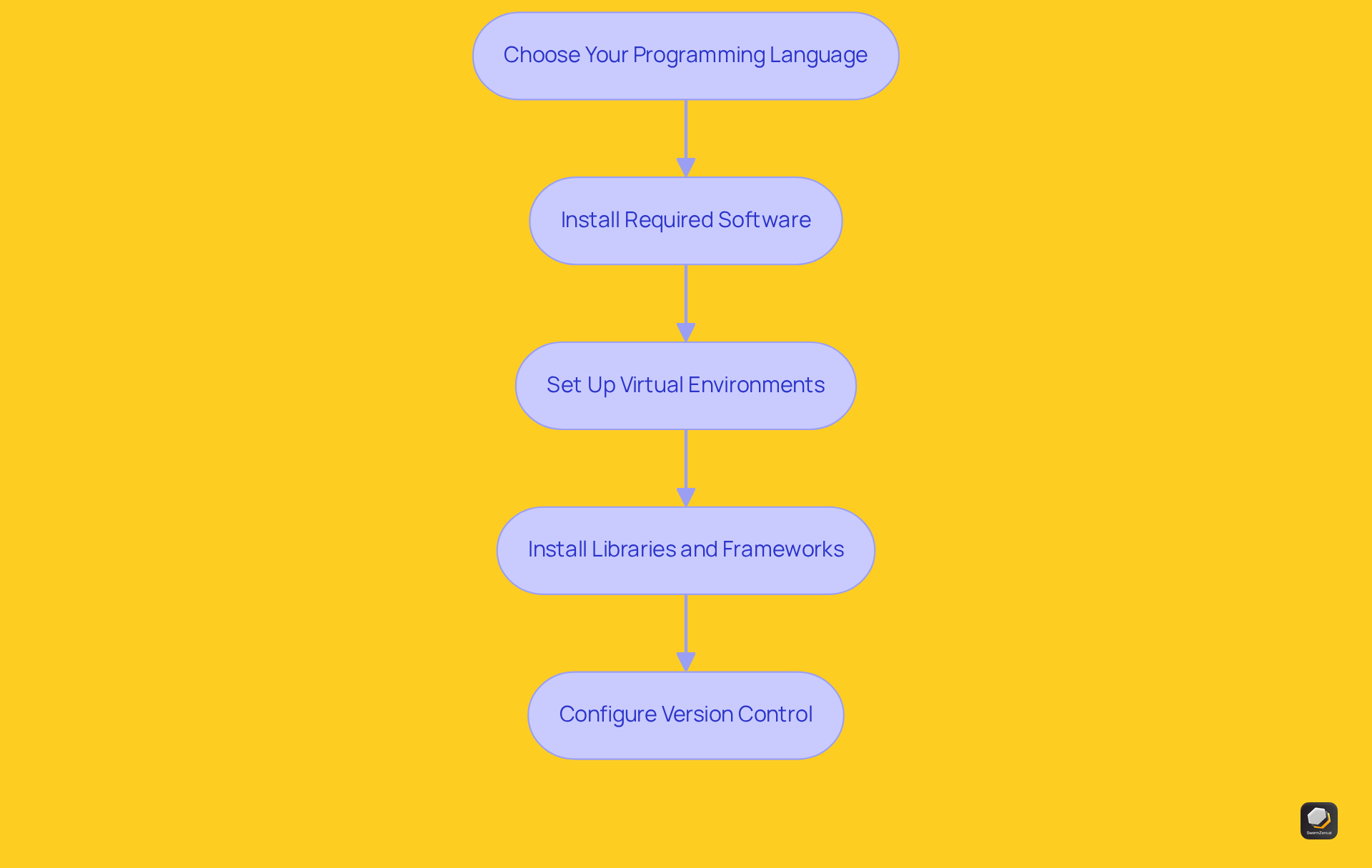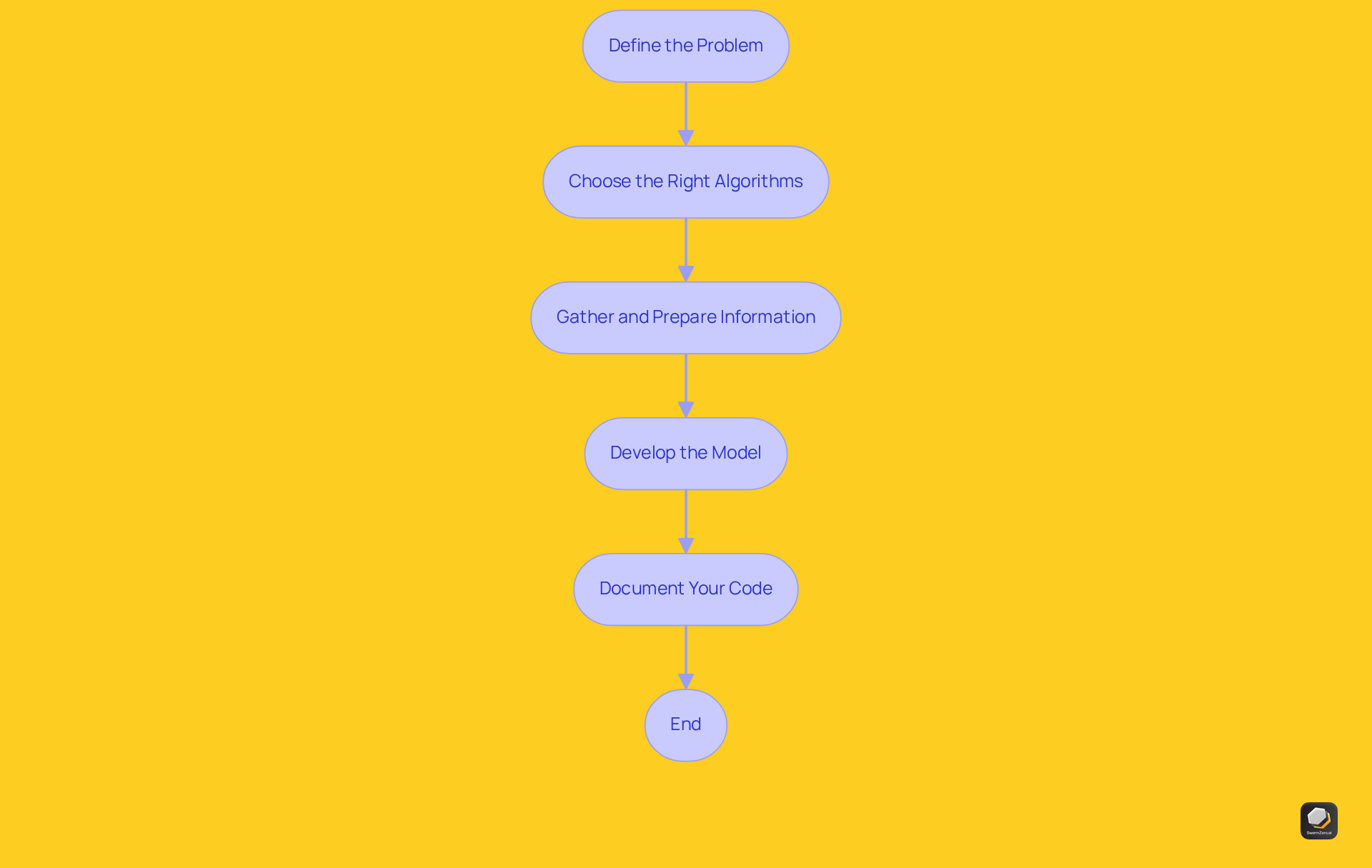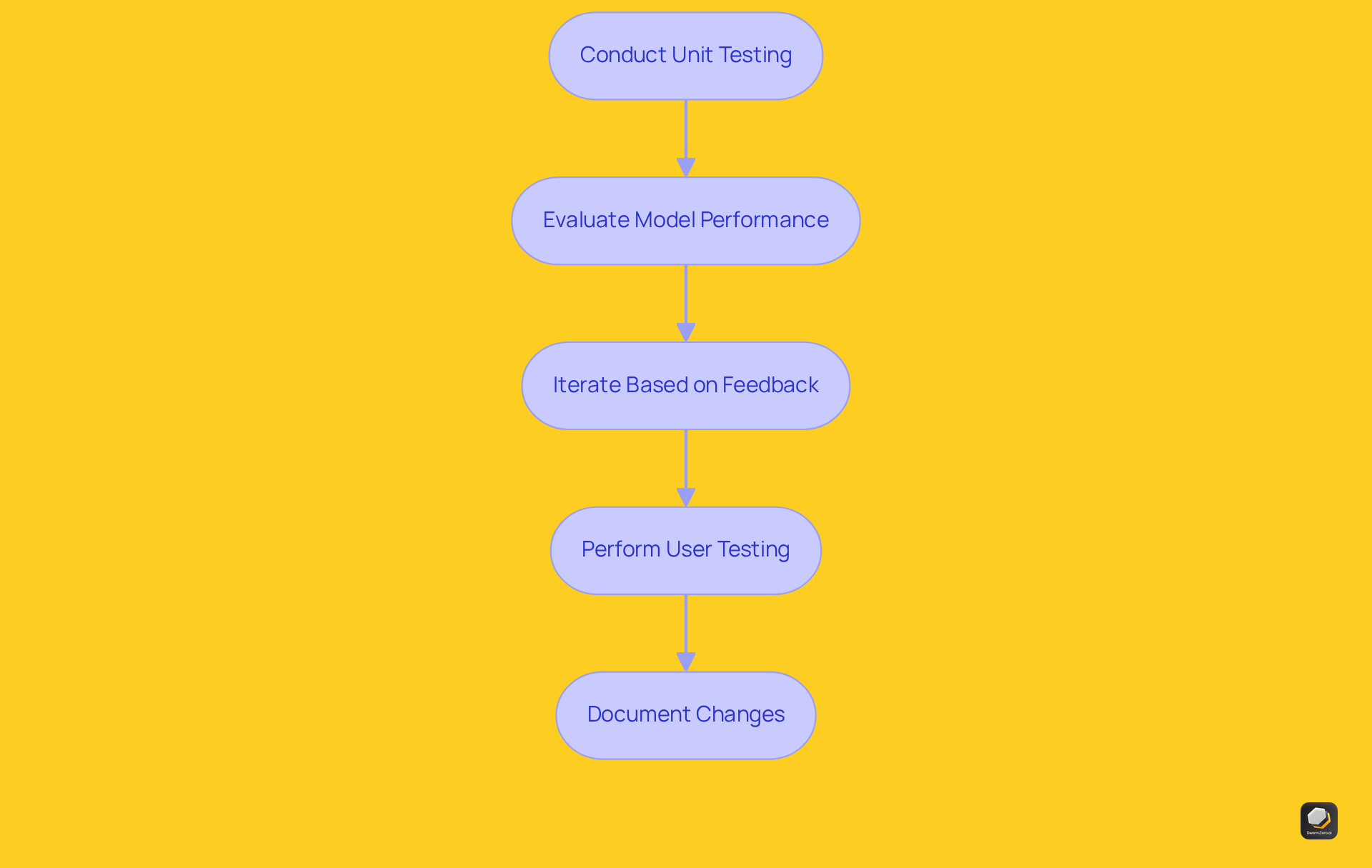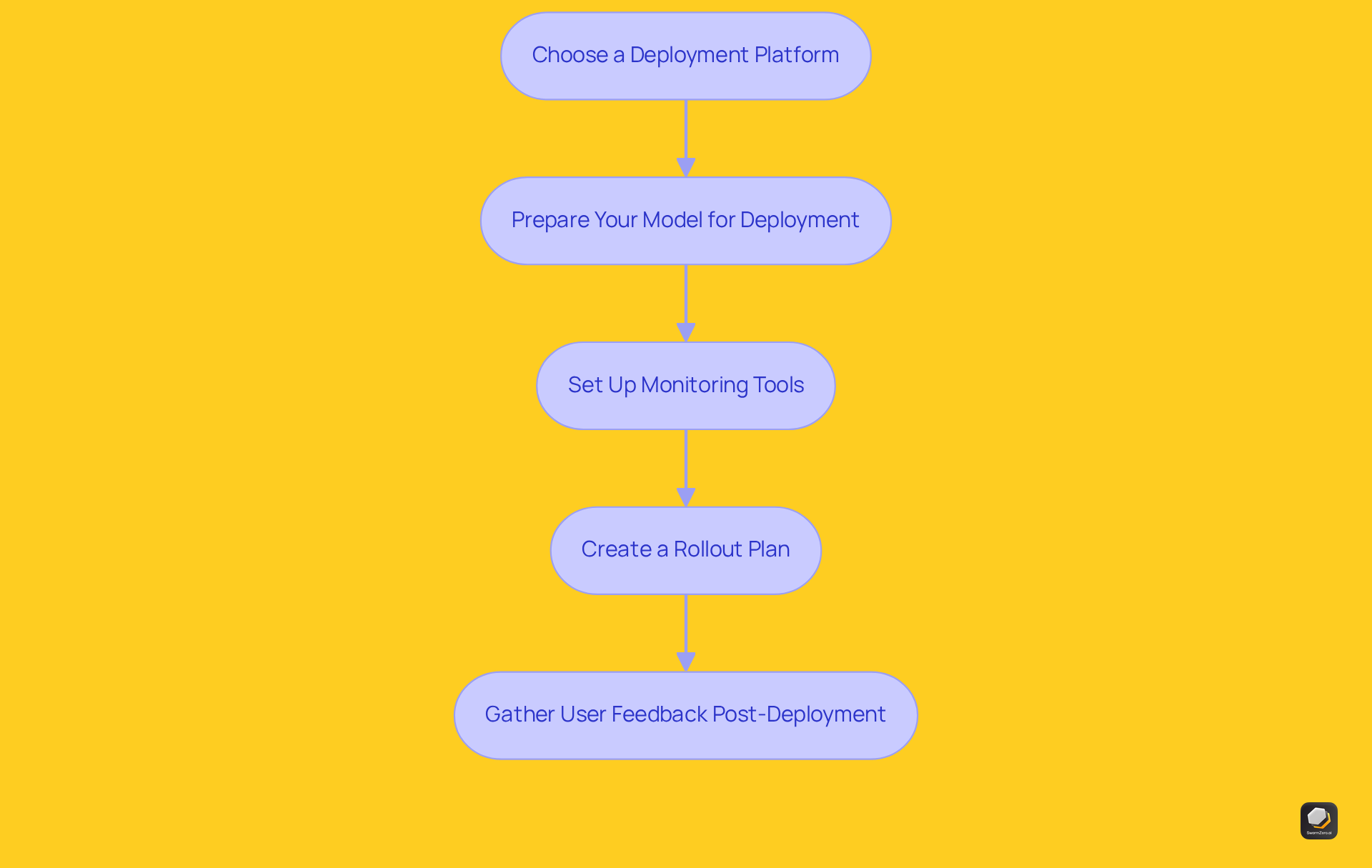5 Steps: How Do You Create an AI Program Effectively
Explore how do you create an AI programme with essential steps from understanding concepts to deployment.

Key Highlights:
- Understanding key AI concepts: AI simulates human intelligence, ML enables learning from experience, Deep Learning uses neural networks, NLP facilitates human-computer language interaction, and algorithms guide AI decision-making.
- The AI market is projected to reach $1,339 billion by 2030, with 64% of business owners believing AI can enhance customer relationships.
- Python is the preferred programming language for AI, with over 60% of developers using it due to its extensive libraries like TensorFlow and PyTorch.
- Setting up a development environment involves choosing a programming language, installing software, creating virtual environments, installing libraries, and configuring version control.
- Key steps in designing an AI programme include defining the problem, selecting appropriate algorithms, gathering and preparing data, developing the model, and documenting the code.
- Testing and refining the AI programme involves unit testing, evaluating model performance, iterating based on feedback, user testing, and documenting changes.
- Effective deployment requires choosing a suitable platform, preparing the model, setting up monitoring tools, creating a rollout plan, and gathering user feedback post-deployment.
Introduction
Creating an AI programme is no small feat; it demands a solid understanding of complex concepts coupled with a structured development approach. As the AI landscape evolves rapidly, grasping key terminologies and best practises becomes essential for developers eager to harness its potential. What are the crucial steps to design and deploy an effective AI application that addresses real-world needs? This article explores five essential steps that guide developers through the intricacies of AI programme creation, equipping them to tackle the challenges that lie ahead.
Understand Key AI Concepts and Terminology
Before embarking on the development of an AI application, it is imperative to understand how do you create an ai programme and familiarise yourself with the essential concepts that underpin artificial intelligence. These include:
- Artificial Intelligence (AI): This term refers to the simulation of human intelligence processes by machines, particularly computer systems, enabling them to perform tasks that typically require human intelligence.
- Machine Learning (ML): A subset of AI, ML allows systems to learn and improve from experience without explicit programming, making it a vital component in developing intelligent applications.
- Deep Learning: This advanced type of ML utilises neural networks with multiple layers to analyse intricate patterns, significantly enhancing the capabilities of AI systems.
- Natural Language Processing (NLP): NLP focuses on the interaction between computers and humans through natural language, enabling machines to understand, interpret, and respond to human language meaningfully.
- Algorithms: These are sets of rules or instructions given to an AI system, guiding it in learning autonomously and making decisions based on data.
Understanding these terms is crucial, as they lay the groundwork for how do you create an ai programme in the subsequent stages of developing your AI application. With the AI market projected to reach $1,339 billion by 2030 and an annual growth rate of 36.6% from 2023 to 2030, grasping these concepts will not only enhance your programme's effectiveness but also position your business to leverage AI's transformative potential across various applications. As noted by Forbes Advisor, "64% of business owners believe AI has the potential to improve customer relationships," underscoring the importance of integrating AI into business strategies.

Set Up Your Development Environment
To establish an effective development environment for AI programming, follow these essential steps:
-
Choose Your Programming Language: Python is the preferred option for AI creation. It is favoured for its extensive libraries, such as TensorFlow and PyTorch, which facilitate machine learning and deep learning tasks. Recent statistics indicate that over 60% of AI developers utilise Python, underscoring its dominance in the field.
-
Instal Required Software: Download and instal an Integrated Development Environment (IDE) like PyCharm or Visual Studio Code. Ensure that Python is properly installed on your system to leverage its capabilities fully.
-
Set Up Virtual Environments: Utilise tools like
venvorcondato create isolated environments for your projects. This practise helps prevent dependency conflicts, ensuring that each project operates smoothly without interference from others. -
Instal Libraries and Frameworks: Employ package managers like
pipto instal essential libraries (e.g., NumPy, Pandas, Scikit-learn) that are crucial for your AI development tasks. These libraries provide the necessary tools for data manipulation, analysis, and machine learning. -
Configure Version Control: Implement Git for version control to effectively track changes in your code and facilitate collaboration with other developers. This phase is vital for maintaining code integrity and managing project evolution over time.
By adhering to these steps, you will create a robust environment that supports your AI development efforts, which will help you understand how do you create an ai programme and position you for success in leveraging AI technologies.

Design and Build Your AI Program
To design and build an effective AI programme, follow these essential steps:
-
Define the Problem: Articulate the specific problem your AI programme aims to address. A well-defined problem statement is crucial, as it guides the entire design and creation process.
-
Choose the Right Algorithms: Select algorithms that correspond with your problem definition. For instance, supervised learning is optimal for classification tasks, whereas unsupervised learning is better suited for clustering. Current trends show a preference for adaptable algorithms, which enhance flexibility in AI applications. As AI researchers emphasise, the right tools are vital for maintaining a competitive edge in AI development.
-
Gather and Prepare Information: Collect high-quality, relevant data related to your problem. Ensure this information is cleaned and preprocessed for effective training of your AI model. The quality of your data significantly influences the performance of your algorithms.
-
Develop the Model: Implement your chosen algorithms by coding effectively. Leverage powerful libraries such as TensorFlow or PyTorch, which simplify the creation process and provide robust tools for model building. Additionally, consider utilising the SwarmZero framework, which streamlines the creation and deployment of AI agents, facilitating task automation and enhancing productivity.
-
Document Your Code: Maintain thorough documentation throughout your coding journey. This practise not only assists others in understanding your work but also serves as a valuable reference for you in the future.
By adhering to these steps, you will lay a solid foundation for your AI initiative, which will effectively demonstrate how do you create an ai programme to address the defined problem. For further resources and tools related to AI development, visit SwarmZero.

Test and Refine Your AI Program
To test and refine your AI programme, adhere to the following steps:
- Conduct Unit Testing: Assess individual components of your application to confirm their proper functionality. Frameworks such as
unittestorpytestare recommended for this purpose. - Evaluate Model Performance: Utilise metrics like accuracy, precision, recall, and F1 score to gauge your model's performance on a validation dataset.
- Iterate Based on Feedback: Examine the outcomes of your tests and refine your model accordingly. This process may involve adjusting parameters, retraining with diverse data, or even altering algorithms.
- Perform User Testing: If applicable, solicit feedback from potential users to pinpoint usability issues and areas for enhancement.
- Document Changes: Maintain a record of all modifications made during the testing phase to ensure a clear history of your application's evolution.
By rigorously testing and refining your AI system, you will significantly enhance its effectiveness, which is crucial when considering how do you create an AI programme and prepare it for deployment.

Deploy Your AI Program Effectively
To deploy your AI programme effectively, follow these steps:
- Choose a Deployment Platform: Selecting the right platform is crucial. Consider cloud services like AWS or Azure for scalability and flexibility, or opt for on-premises solutions if data security is a priority. Industry leaders emphasise that the choice of deployment platform can significantly impact the performance and accessibility of AI applications. SwarmZero enhances this process with its integration capabilities, particularly through the Tavily API, which provides advanced AI-powered processing for web searches.
- Prepare Your Model for Deployment: Ensure your model is optimised for performance and can handle the expected load. This may involve converting it to a format suitable for the deployment environment, which is essential for maximising efficiency and responsiveness. Utilising SwarmZero's Agent Builder streamlines this process, allowing you to customise your AI agents for specific tasks and fully leverage the SwarmZero framework's capabilities.
- Set Up Monitoring Tools: Implement monitoring solutions to track the performance of your AI system in real-time. This proactive approach helps in identifying issues quickly, allowing for timely interventions that can enhance user experience and system reliability. Choose monitoring tools that align with SwarmZero's capabilities to ensure seamless integration and optimal performance of your AI-powered web search agents.
- Create a Rollout Plan: Develop a strategy for gradually introducing your AI initiative to users. This may include beta testing phases to gather initial feedback and make necessary adjustments before a full-scale launch, ensuring a smoother transition and higher user satisfaction. Successful deployment strategies often involve phased rollouts to mitigate risks, particularly when utilising SwarmZero's comprehensive features.
- Gather User Feedback Post-Deployment: After deployment, continue to collect feedback from users to identify areas for improvement. This iterative process is vital for refining your AI application and ensuring it meets user needs effectively. Engaging with users can provide insights that enhance the functionality of your AI agents, especially those built on the SwarmZero framework.
By following these steps, you will ensure a successful deployment of your AI programme, which will help you understand how do you create an AI programme for its effective use in real-world applications. Statistics indicate that cloud deployments are increasingly favoured over on-premises solutions due to their scalability and cost-effectiveness, making them a popular choice among businesses looking to leverage AI technology.

Conclusion
Creating an AI programme effectively requires a structured approach that encompasses essential steps, from understanding fundamental concepts to deploying a fully functional application. Each phase of development is critical in ensuring that the AI solution meets its intended purpose and operates efficiently in real-world scenarios.
This article outlines key stages:
- Beginning with a solid foundation in AI terminology
- Establishing an appropriate development environment
- Designing and building the programme
- Rigorously testing and refining it
- Finally, deploying it effectively
Each step is crafted to guide developers through the complexities of AI programming, emphasising the importance of thorough preparation, quality data, and continuous feedback throughout the process.
Ultimately, the journey of creating an AI application is both challenging and rewarding. By adhering to the outlined steps and best practises, developers can harness the transformative power of AI, leading to innovative solutions that significantly enhance business operations and user experiences. Engaging with this evolving field positions developers for success and contributes to the broader adoption of AI technologies across industries.
Frequently Asked Questions
What are the key concepts and terminology related to artificial intelligence (AI)?
Key concepts include Artificial Intelligence (AI), which simulates human intelligence processes; Machine Learning (ML), a subset of AI that enables systems to learn from experience; Deep Learning, which uses neural networks to analyse complex patterns; Natural Language Processing (NLP), focusing on human-computer interaction through natural language; and Algorithms, which are sets of rules guiding AI systems in learning and decision-making.
Why is it important to understand AI concepts before developing an AI application?
Understanding AI concepts is crucial as they lay the groundwork for creating an AI programme. Familiarity with these terms enhances the effectiveness of the programme and positions businesses to leverage AI's transformative potential across various applications.
What programming language is preferred for AI development?
Python is the preferred programming language for AI development due to its extensive libraries, such as TensorFlow and PyTorch, which facilitate machine learning and deep learning tasks. Over 60% of AI developers utilise Python.
What steps should I follow to set up an effective development environment for AI programming?
To set up an effective environment, you should choose Python as your programming language, instal required software (like an IDE), set up virtual environments to avoid dependency conflicts, instal essential libraries using package managers, and configure version control with Git.
What are the benefits of using virtual environments in AI development?
Virtual environments help prevent dependency conflicts by isolating projects, ensuring that each project operates smoothly without interference from others.
How can I manage libraries and frameworks necessary for AI development?
You can manage libraries and frameworks by using package managers like pip to instal essential libraries such as NumPy, Pandas, and Scikit-learn, which are crucial for data manipulation, analysis, and machine learning tasks.
What role does version control play in AI development?
Version control, implemented through tools like Git, is vital for tracking changes in code, facilitating collaboration with other developers, maintaining code integrity, and managing the evolution of projects over time.
List of Sources
- Understand Key AI Concepts and Terminology
- 22 Top AI Statistics And Trends (https://forbes.com/advisor/business/ai-statistics)
- 131 AI Statistics and Trends for (2024) | National University (https://nu.edu/blog/ai-statistics-trends)
- AI Statistics: 77% Of Businesses Are Already Using AI (https://wingmansolutions.ca/ai-statistics)
- Topic: Artificial intelligence (AI) worldwide (https://statista.com/topics/3104/artificial-intelligence-ai-worldwide)
- 100+ AI Statistics Shaping Business in 2025 - Vena (https://venasolutions.com/blog/ai-statistics)
- Set Up Your Development Environment
- AI in Software Development: Real-World Benefits, Challenges, and Guidance (https://aloa.co/blog/the-role-of-ai-in-software-development-trends-statistics-and-growth)
- AI in Software Development: Trends, Stats, and Growth (https://linkedin.com/pulse/ai-software-development-trends-stats-growth-intechno-software-inrwc)
- Top 40 AI Stats in Software Development in 2025 You Won't Believe (But Need to Know) (https://softura.com/blog/ai-powered-software-development-statistics-trends)
- Five AI Programming Languages to Consider Using in 2025 (https://opsmatters.com/posts/five-ai-programming-languages-consider-using-2025)
- Design and Build Your AI Program
- New system enables robots to solve manipulation problems in seconds (https://news.mit.edu/2025/new-system-enables-robots-to-solve-manipulation-problems-seconds-0605)
- Top AI Tools for Algorithms in 2025 (https://codewave.com/insights/top-ai-tools-algorithms)
- PESPod #24: AI, Algorithms and Digital Trends (https://employment-social-affairs.ec.europa.eu/news/pespod-24-ai-algorithms-and-digital-trends-2025-05-15_en)
- Google DeepMind’s new AI agent cracks real-world problems better than humans can (https://technologyreview.com/2025/05/14/1116438/google-deepminds-new-ai-uses-large-language-models-to-crack-real-world-problems)
- Google DeepMind’s new AI system can evolve new algorithms (https://emergingtechbrew.com/stories/2025/05/27/google-deepmind-ai-system-new-algorithms)
- Test and Refine Your AI Program
- From QE To AI: Leading The Future Of Software Testing (https://forbes.com/councils/forbestechcouncil/2025/03/25/from-qe-to-ai-leading-the-future-of-software-testing)
- How AI & other trends are reshaping QA in 2025 - Xray Blog (https://getxray.app/blog/how-ai-other-trends-are-reshaping-qa-in-2025)
- Using Artificial Intelligence in Software Testing (https://infoq.com/news/2025/04/AI-software-testing)
- AI in Software Testing 2025: How It’s Making QA Smarter (https://ishir.com/blog/142281/5-ways-ai-is-making-software-testing-smarter-and-faster-in-2025.htm)
- How AI Is Transforming Software Testing in 2025 (https://parkmagazineny.com/how-ai-is-transforming-software-testing-in-2025)
- Deploy Your AI Program Effectively
- 28 Best Quotes About Artificial Intelligence | Bernard Marr (https://bernardmarr.com/28-best-quotes-about-artificial-intelligence)
- 35 AI Quotes to Inspire You (https://salesforce.com/ca/artificial-intelligence/ai-quotes)
- 100 of My Favorite Quotes on Artificial Intelligence (https://techpoint.africa/guide/100-of-my-favorite-artificial-intelligence-quotes)
- 75 Quotes About AI: Business, Ethics & the Future (https://deliberatedirections.com/quotes-about-artificial-intelligence)




